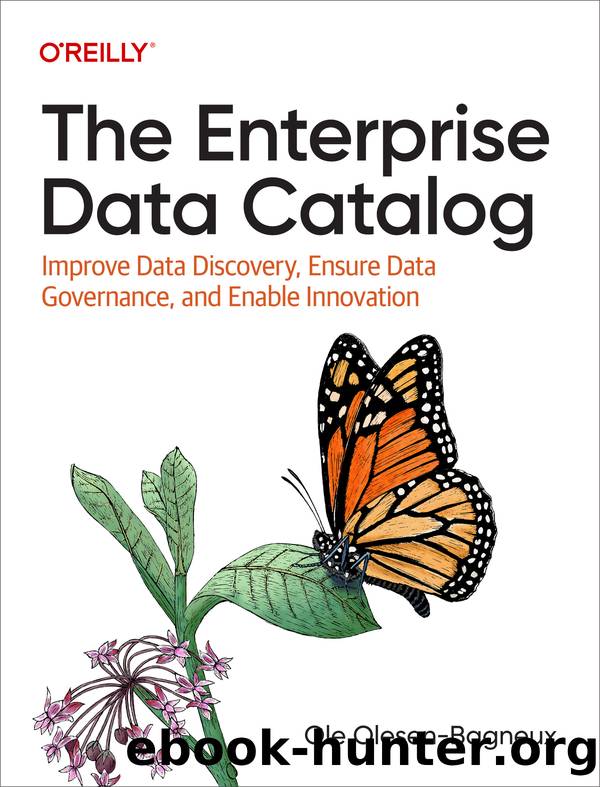The Enterprise Data Catalog by Ole Olesen-Bagneux

Author:Ole Olesen-Bagneux
Language: eng
Format: epub
Publisher: O'Reilly Media
Published: 2023-02-22T00:00:00+00:00
Figure 4-9. Graph browsing
Note
As you have just read, search is a process. In many cases, it will be a series of searches that increase, decrease, and refocus search results, until the search finally matches the information needed.
Searching a Graph-Based Data Catalog
As depicted in Figure 3-4, search can be divided into a spectrum. It goes from easy executable simple searches to more-complex advanced searches. In the latter case, the end user has to remember both the syntax of the IRQL and assess if the semantics of the query statement actually reflect what is being searched for. This is demanding, but useful. The IRQL that the user searches with has been designed by the data catalog providerâI consider DCQL as the minimum acceptable IRQL. It is likely that the IRQL will expand over time, as the technology evolves with the feedback from customers. But an IRQL will never allow you to search for everything.
However, for knowledge graphâbased data catalogs, it is possible to push search even further and actually search for everything in the data catalog. It requires search skills beyond the IRQL of the specific catalog: instead, here you would have to master the DQL that matches the technology of the catalog in question, for example, SPARQL, Cypher, or Gremlin. Take into consideration that data lineage can be graph-based as well and that, if so, this makes data lineage searchable in a similar fashion.
Searching with a DQL inside a data catalog requires a technical skill set that not all data catalog use cases rely upon. But if you truly want to organize your data just as you like, and search it however you want, then this is what it takes. Think of it like this: an IRQL is always designed by the provider; it will contain some of the elements that are useful to search for, and leave others out. But the graph DQL lets you search for everything you want because it is set up to search for everything that the metamodel contains, however it has been defined.
Download
This site does not store any files on its server. We only index and link to content provided by other sites. Please contact the content providers to delete copyright contents if any and email us, we'll remove relevant links or contents immediately.
Exploring Deepfakes by Bryan Lyon and Matt Tora(8310)
Robo-Advisor with Python by Aki Ranin(8263)
Offensive Shellcode from Scratch by Rishalin Pillay(6394)
Microsoft 365 and SharePoint Online Cookbook by Gaurav Mahajan Sudeep Ghatak Nate Chamberlain Scott Brewster(5633)
Ego Is the Enemy by Ryan Holiday(5297)
Management Strategies for the Cloud Revolution: How Cloud Computing Is Transforming Business and Why You Can't Afford to Be Left Behind by Charles Babcock(4528)
Python for ArcGIS Pro by Silas Toms Bill Parker(4477)
Elevating React Web Development with Gatsby by Samuel Larsen-Disney(4192)
Machine Learning at Scale with H2O by Gregory Keys | David Whiting(4192)
Liar's Poker by Michael Lewis(3372)
Learning C# by Developing Games with Unity 2021 by Harrison Ferrone(3335)
Speed Up Your Python with Rust by Maxwell Flitton(3280)
OPNsense Beginner to Professional by Julio Cesar Bueno de Camargo(3252)
Extreme DAX by Michiel Rozema & Henk Vlootman(3237)
Agile Security Operations by Hinne Hettema(3161)
Linux Command Line and Shell Scripting Techniques by Vedran Dakic and Jasmin Redzepagic(3151)
Essential Cryptography for JavaScript Developers by Alessandro Segala(3122)
Cryptography Algorithms by Massimo Bertaccini(3058)
AI-Powered Commerce by Andy Pandharikar & Frederik Bussler(3026)
